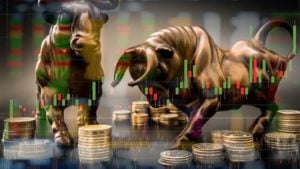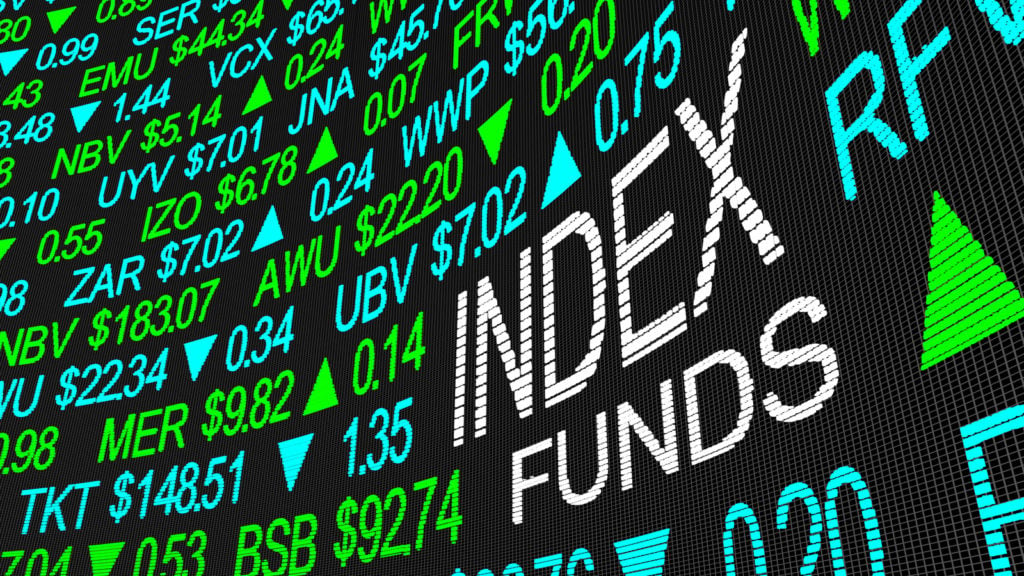Index funds are a great investment vehicle. They allow investors to track a specific stock market index such as the S&P 500, or a sector of the economy like technology companies. Additionally, index funds are known as a “passive investment” because they automatically track an underlying stock index. In this way, index funds provide investors with diversification and exposure to a number of different companies. That said, some of the top tickers on Wall Street are a few of the best index funds to buy.
Moreover, index funds are also cheaper to own than actively managed mutual funds, and the returns of index funds have been known to outperform the returns on actively managed funds over time. In 2007, Warren Buffett made a $1 million bet that an S&P 500 index fund would beat the returns of an actively managed hedge fund over a ten year period — and he won.
Therefore, index funds can be a fruitful investment if you play your cards right. And with that in mind, let’s take a look at seven of the best index funds to buy on the market right now.
They are:
- Invesco QQQ Fund (NASDAQ:QQQ)
- Vanguard Information Technology Fund(NYSEARCA:VGT)
- The SPDR S&P 500 Trust (NYSEARCA:SPY)
- SPDR Gold Trust (NYSEARCA:GLD)
- Vanguard Total Stock Market Fund (NYSEARCA:VTI)
- iShares Treasury Bond Fund (NASDAQ:IEF)
- Invesco Golden Dragon China Fund (NASDAQ:PGJ)
So, let’s dive in.
Index Funds to Buy Today: Invesco QQQ (QQQ)

The Invesco QQQ index fund has many names — the “triple-Qs” or “cubes” or simply the “Q.” However, there is no denying the appeal of this widely-held index fund that tracks the Nasdaq-100 stock market index. The Nasdaq-100 is comprised of the 100 largest international and domestic companies — excluding financial concerns such as banks — that are listed on the Nasdaq stock exchange, based on market capitalization. This means that the Nasdaq — and by extension, the QQQ index fund — is heavily weighted toward large-cap technology companies, and is often viewed as a benchmark of how the broad technology sector is performing.
In turn, owning the QQQ index fund provides exposure to the so called “FAANG” stocks: Facebook (NASDAQ:FB), Amazon (NASDAQ:AMZN), Apple (NASDAQ:AAPL), Netflix (NASDAQ:NFLX), Microsoft (NASDAQ:MSFT), and Alphabet (NASDAQ:GOOG,NASDAQ:GOOGL) (the parent company of Google).
Investors also get exposure to many other great companies such as PayPal (NASDAQ:PYPL) and PepsiCo (NASDAQ:PEP) through the QQQ index fund. And, with technology companies leading the current bull market and the Nasdaq at an all-time high, the QQQ is also performing exceptionally well right now. In fact, it is up 28.3% year-to-date, and up nearly 60% since its March lows amid the Covid-19 market collapse.
So, collectively, QQQ is one of the best index funds to buy.
Vanguard Information Technology Fund (VGT)

Vanguard is an industry leader when it comes to index funds. And today, Vanguard offers a number of different index funds at a fraction of the cost of actively managed mutual funds.
One of Vanguard’s best performing index funds is its Information Technology Exchange Traded Fund (ETF) known by its ticker symbol “VGT.” While not replicating the Nasdaq 100 as the Invesco QQQ does, the VGT fund tracks benchmark stocks in the information technology sector.
Overall, investors in VGT gain exposure to all the big technology companies, as well as a number of smaller technology companies. In turn, the VGT index fund provides impressive returns to investors. In fact, so far this year, the fund is up more than 24%. And over the past five years, VGT’s average annual return is 24.3%. Investors who had put $10,000 in VGT back in 2010 and left it there would have more than $60,000 today. Another benefit of the VGT fund is its low expense ratio of just 0.10%. That’s among the lowest in the industry and it leaves more money in investors’ pockets.
Therefore, VGT is another great option for investors looking for index funds to buy.
Index Funds to Buy Today: The SPDR S&P 500 Trust (SPY)

Investors wanting exposure beyond the technology sector should consider the SPDR S&P 500 ETF, known as “SPY.” This index fund is designed to track the S&P 500 stock market index, and is the largest ETF in the world.
Many investing experts, including Warren Buffett, recommend that retail investors put their money in an index fund that tracks the S&P 500 stock market index — claiming that doing so provides all the diversification most investors will ever need.
The Standard & Poor’s 500 Index, or S&P 500, is a stock market index made up of the 500 largest U.S. publicly traded companies by market capitalization. That said, investing in the SPY index fund that tracks the S&P 500 gets investors exposure to stocks of companies such as Johnson & Johnson (NYSE:JNJ), Visa (NYSE:V), Proctor & Gamble (NYSE:PG), Mr. Buffett’s Berkshire Hathaway (NYSE:BRK.B), as well as all of the FAANG stocks.
The S&P 500 has performed well historically over long periods of time. In the past 10 years, the SPY index fund has matched the average annual return of the S&P 500 at 13.84%. This fund too has a comparatively low expense ratio of 0.095%.
SPDR Gold Trust (GLD)

Gold is hot right now, and one of the best ways to gain exposure to the precious metal is through the SPDR Gold Trust index fund. Managed by State Street Global Advisors, “GLD” has — at various times — been the largest index fund in the world, depending on what is happening with the price of gold. This index fund is also unique in that it actually holds gold bullion.
Many gold index funds simply hold shares in companies that mine and/or process gold. But in the SPDR Gold Trust, the fund’s manager actually exchanges blocks of 100,000 shares for 10,000 ounces of gold. At the end of 2019, the trust had nearly 25 million ounces of gold in its custody, worth $31.70 billion. That makes the SPDR Gold Trust index fund one of the top 10 largest holders of gold in the world.
With the price of gold hitting record levels in recent months, the GLD index fund has also been performing exceptionally well. YTD, the index fund is up 27% at $181.5 per share. Of course, the fund’s performance is entirely dependent on the price of gold. But as long as the precious metal’s price is rising, this is a good investment.
Over the past three years, the GLD index fund has produced an annual rate of return of 12%. But over 10 years, the results are less impressive at 3.16%. The expense ratio is a little higher than other index funds on this list at 0.40%. But, again, for investors wanting exposure to gold, it’s hard to beat the SPDR Gold Trust.
Index Funds to Buy Today: Vanguard Total Stock Market Fund (VTI)

Have you ever dreamed of owning the entire stock market? Want exposure to large cap, mid cap and small cap companies? Like the idea of being invested in the whole market — good and bad?
Well, this is an option thanks to Vanguard’s Total Stock Market Fund. With VTI, investors get exposure to all sizes of companies spanning every economic sector — from technology and financials to healthcare, consumer goods, oil and gas and beyond. The main benefit of this index fund is its huge diversification, as this one fund provides exposure to the entire U.S. economy.
Of course, the fund’s top holdings are stocks of the larger companies that have already been mentioned – Apple, Facebook and Johnson & Johnson. But investors also gain access to companies such as UnitedHealth Group (NYSE:UNH) and Bank of America (NYSE:BAC), among many others. The expense ratio on this index fund is rock bottom at just 0.03%. And VTI has performed well over time, averaging annual returns of 10% after three years and nearly 14% after 10 years. An investment in this fund of $10,000 in 2010 would be worth more than $35,000 today.
So, if you’re looking for exposure to the entire market, then VTI is one of the best index funds to buy.
iShares 7-10 Year Treasury Bond Fund (IEF)

Index funds are not only available for stocks. There are also index funds that provide investors with access to fixed income vehicles, or bonds. One of the better bond funds is the iShares 7-10 Year Treasury Bond Fund.
This fund provides exposure to rock solid U.S. Treasury bonds, typically ones that mature after seven to 10 years. The upside of this type of index fund is that it is stable and secure, and not nearly as volatile as index funds that track a particular stock market or economic sector. The downside is that bond funds such as this one do not have as much growth potential as equity funds (stocks), and they tend to have a low yield (1.6% in this case).
Still, a well diversified portfolio contains a certain percentage of fixed income investments (the older you are the higher the percentage of fixed income should be). And there are few investments more reliable than U.S. Treasuries. This is an index fund that allows investors to sleep soundly at night. The expense ratio is a little higher at 0.15%, but that is still relatively cheap.
And with the market volatility experienced this year, the IEF index fund can provide some much needed stability to a portfolio. Plus, this bond index fund is up a healthy 10.3% YTD.
Index Funds to Buy Today: Invesco Golden Dragon China Fund (PGJ)

In addition to domestic U.S. markets, there are a number of index funds focused on foreign companies and stock exchanges. One such index fund is Invesco’s Golden Dragon China Fund. This fund is focused on leading Chinese companies such as Alibaba (NYSE:BABA) JD.com (NASDAQ:JD) and Baidu (NASDAQ:BIDU). China is the world’s fastest growing economy, and investing in this type of fund gives investors access to high growth margins. It also is a safer way to invest in the China growth story than buying shares of individual companies.
However, China is the wild west when it comes to investing and U.S.-China relations remain strained. As such, investors should expect a fair share of volatility from the PGJ fund. In the last year, this fund is up 54.8%, and has risen nearly 125% over the past decade. Note, though, that this fund is among the most expensive to own on this list with an expense ratio of 0.70%.
Regardless, for investors who want foreign exposure, particularly to China, this is one of the smartest and safest ways to go about it. The broad diversification should help ease the volatility associated with investing in Chinese companies.
Joel Baglole has been a business journalist for 20 years. He spent five years as a staff reporter at The Wall Street Journal, and has also written for The Washington Post and Toronto Star newspapers, as well as financial websites such as The Motley Fool and Investopedia. As of this writing, Joel held shares of AAPL, MSFT, BRK.B, BAC, BABA, V, QQQ, VGT and GLD.
